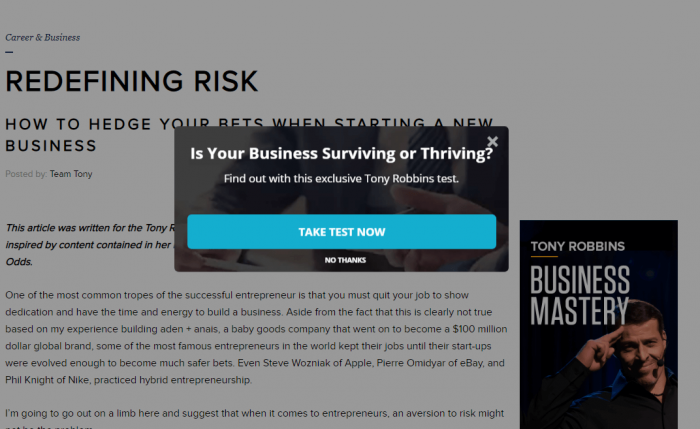Pop-up
Contents
Definition
A pop-up is a graphical user interface and a popular advertising medium in online marketing. Pop-ups usually appear directly on an active website and cover parts of the original content. They are mainly used for advertising purposes or to animate users to further interact with a website.
Types of pop-ups
There are basically three different types of pop-ups, which are distinguished by the location where they open. They can appear in a separate browser window, in a dialog box, or as an element - for example - in a lightbox. Pop-ups opening in separate windows direct users to an external page that cannot be closed in the original window. This option is often used if the link leads directly to an ad.
The second option is to open the pop-up as a dialog box. This is another element that covers parts of the website’s actual content. The dialog window contains elements such as buttons that prompt the user to interact. Visitors have to close the pop-up to see the website's original content.
Pop-ups can also be integrated directly into the site. An example could be lightboxes that are only visible on the respective page and disappear when it is closed.
Advantages and disadvantages
Pop-up elements are frequently used in online marketing and targeted advertising. They offer many advantages when used correctly and in the right amount. They are particularly useful in product advertising and the service sector, as well as for providing additional information on a certain topic. Newsletter registrations, for example, can be increased by up to 50% with the help of pop-up elements. However, you should always make sure that the pop-up is not too intrusive and that you tailor its content to your users’ individual requirements and interests. In the best case, pop-ups provide valuable additional information and thus become a helpful element in online marketing.
However, there are also disadvantages to pop-up ads that you have to keep in mind. For example, potential customers may be annoyed by too many windows on a page and the frequent display of ads. Covering a page's entire content with pop-up ads is also counterproductive. Designing successful pop-ups requires competence, careful thought and the goal of providing real value to users. If this is given, pop-up elements can be an effective way for increasing the satisfaction of website visitors.
Ways of blocking pop-ups
Many users configure their browsers to block pop-up ads in general. This blocks all windows that are not embedded in a website but opened externally or in a content overlapping way. Windows embedded in a site are not affected by this because they are not recognized as pop-up despite user settings. Depending on users’ browsers, there are different ways and options for blocking pop-ups. In their browser settings, users can choose whether all pop-ups should be blocked or whether pop-ups should be activated or deactivated manually. With the latter setting, an existing pop-up will be displayed once and users can decide if they want to block it or not. If the user rejects the display, the element remains closed and the ad is not displayed.
Importance for online marketing and SEO
Pop-ups can be an effective tool in online marketing. By using these elements for advertising purposes, you can increase your visibility on the web and thus achieve higher sales. Another effective way to use pop-ups is to animate users to register for a newsletter or to integrate them for registration forms. Ideally, you want to concentrate on a small window that opens directly on your website, because if external windows are opened, potential customers can deactivate or close them as soon as they appear. Another use for pop-up windows are exit intent pop-ups. By tracking your visitors’ mouse movements, a Javascript can tell when they are about to leave the website. Before they do, a pop-up opens and offers them an incentive to stay (for example a discount).
In terms of search engine optimization (SEO), you should use pop-ups with caution as Google might interpret them as the main content of your page. Since content is an essential ranking factor, this can have considerable consequences for your website’s search engine rankings. To prevent such misinterpretation, a pop-up should only be displayed after the website has been opened for a while. A pop-up that opens immediately is more likely to annoy users as well. In addition, since January 10, 2017, Google has been punishing mobile websites where pop-ups cover the main content because these strongly impair user experience.
To summarize, using pop-up elements requires know-how and expertise in making the necessary adjustments. High-quality content, the right placement, and appropriate intervals of display support your company's advertising success. Using pop-ups as elements that are integrated into the site proves to be the best option both for usability and search engine optimization.
An example of a well-used pop-up can be found on tonyrobbins.com. After you spent some time on the website, the following pop-up appears, asking you to take a test:

Screenshot with a pop-up of tonyrobbins.com
Related links
- https://searchengineland.com/google-confirms-rolling-mobile-intrusive-interstitials-penalty-yesterday-267408
- https://www.smartbugmedia.com/blog/do-pop-up-ads-actually-work-heres-the-data-you-need
Similar articles
| About the author |
 |